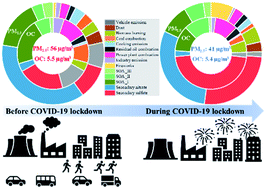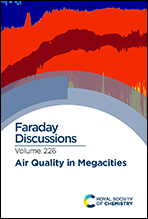Tracer-based characterization of source variations of PM2.5 and organic carbon in Shanghai influenced by the COVID-19 lockdown†
Abstract
Air quality in megacities is significantly impacted by emissions from vehicles and other urban-scale human activities. Amid the outbreak of Coronavirus (COVID-19) in January 2020, strict policies were in place to restrict people’s movement, bringing about steep reductions in pollution activities and notably lower ambient concentrations of primary pollutants. In this study, we report hourly measurements of fine particulate matter (i.e., PM2.5) and its comprehensive chemical speciation, including elemental and molecular source tracers, at an urban site in Shanghai spanning a period before the lockdown restriction (BR) (1 to 23 Jan. 2020) and during the restriction (DR) (24 Jan. to 9 Feb. 2020). The overall PM2.5 was reduced by 27% from 56.2 ± 40.9 (BR) to 41.1 ± 25.3 μg m−3 (DR) and the organic carbon (OC) in PM2.5 was similar, averaged at 5.45 ± 2.37 (BR) and 5.42 ± 1.75 μgC m−3 (DR). Reduction in nitrate was prominent, from 18.1 (BR) to 9.2 μg m−3 (DR), accounting for most of the PM2.5 decrease. Source analysis of PM2.5 using positive matrix factorization modeling of comprehensive chemical composition, resolved nine primary source factors and five secondary source factors. The quantitative source analysis confirms reduced contributions from primary sources affected by COVID-19, with vehicular emissions showing the largest drop, from 4.6 (BR) to 0.61 μg m−3 (DR) and the percentage change (−87%) in par with vehicle traffic volume and fuel sale statistics (−60% to −90%). In the same time period, secondary sources are revealed to vary in response to precursor reductions from the lockdown, with two sources showing consistent enhancement while the other three showing reductions, highlighting the complexity in secondary organic aerosol formation and the nonlinear response to broad primary precursor pollutants. The combined contribution from the two secondary sources to PM2.5 increased from 7.3 ± 6.6 (BR) to 14.8 ± 9.3 μg m−3 (DR), partially offsetting the reductions from primary sources and nitrate while their increased contribution to OC, from 1.6 ± 1.4 (BR) to 3.2 ± 2.0 μgC m−3 (DR), almost offset the decrease coming from the primary sources. Results from this work underscore challenges in predicting the benefits to PM2.5 improvement from emission reductions of common urban primary sources.

- This article is part of the themed collection: Air quality in megacities


 Please wait while we load your content...
Please wait while we load your content...